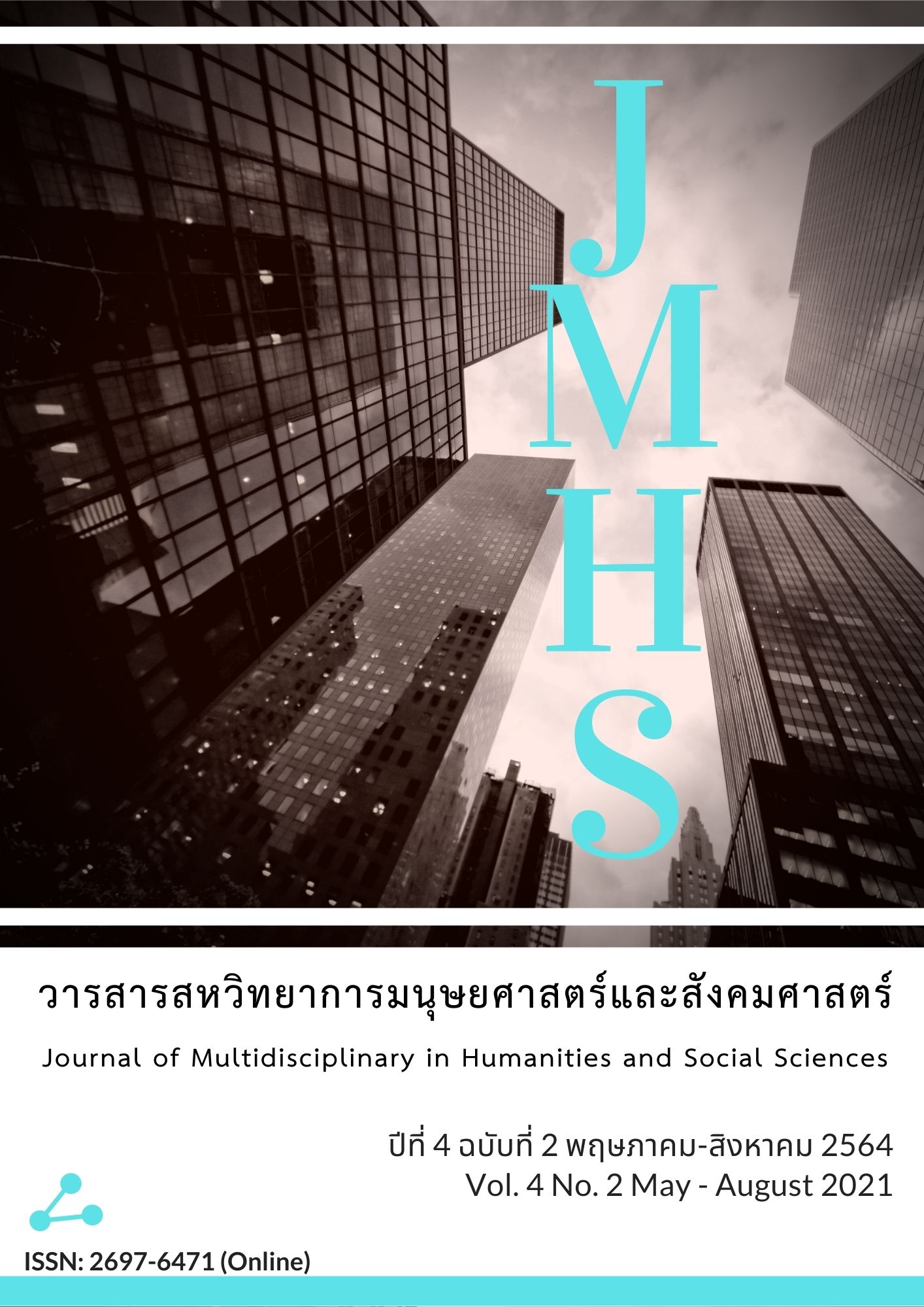Causal Relationship Model of Used Cameras Purchase Intention on Facebook Page Konkaiklong-CameraTown of Consumers in Bangkok and Its Vicinity
Main Article Content
Abstract
This article aimed to study 1) develop a causal relationship model of used cameras purchase intention on Facebook page Konkaiklong-CameraTown of consumers in Bangkok and its vicinity, and 2) validate the consistency a causal relationship model of used cameras purchase intention on Facebook page Konkaiklong-CameraTown of consumers in Bangkok and its vicinity. This study was a quantitative research. The sample was people who have bought used cameras on Facebook page Konkaiklong-CameraTown of consumers in Bangkok and its vicinity of 310 people. The tools used in the research were online questionnaires. The statistics used in data analysis were frequency, percentage, and Structural equation Model.
The results of this research were the development of the causal relationship models consisted of consisting of 4 components were 1) Social Media, 2) Trust, 3) Perceived Usefulness, and 4) Purchase Intention and the model was consistent with the empirical data to a greater extent. The statistic showed the Chi-square statistics goodness fit test (c2) = 184.98, degrees of freedom (df) = 184.98, CMIN / df = 1.46, GFI = 0.95, AGFI = 0.91, SRMR = 0.04, RMSEA = 0.04. The final was predictive coefficient of 0.72 indicating that the variables in the model can explain the variance of the Purchase Intention to buy used cameras on Facebook page Konkaiklong-CameraTown by 72 percent and Perceived Usefulness were the most direct influence on Purchasing Intention to buy used cameras on Facebook page Konkaiklong-CameraTown of consumers in Bangkok and its vicinity. The results of this research were useful to entrepreneurs or those interested in selling products used cameras on Facebook page. The information can be applied in marketing planning, creating strategies to suit and meet the needs of customers in the future.
Article Details
Views and opinions appearing in the Journal it is the responsibility of the author of the article, and does not constitute the view and responsibility of the editorial team.
References
กริช แรงสูงเนิน. (2554). การวิเคราะห์ปัจจัยด้วย SPSS AMOS เพื่อการวิจัย. กรุงเทพฯ: ซีเอ็ดยูเคชั่น.
ชไมพร กาญจนกิจสกุล. (2555). ระเบียบวิธีวิจัยทางสังคมศาสตร์. ตาก: โพรเจ็คท์ไฟฟ์-โฟว์.
จักรกริช ปิยะ. (2557). การศึกษาการใช้สื่อสังคมออนไลน์ (Social media) เพื่อการบริหารงานก่อสร้าง กรณีศึกษาห้างหุ้นส่วน จำกัด เทคโนบิวเดอร์ (2001) อำเภอเมือง จังหวัดนครราชสีมา(วิทยานิพนธ์วิศวกรรมศาสตรมหาบัณฑิต). มหาวิทยาลัยเทคโนโลยีสุรนารี.
จิดาภา ทัดหอม. (2560). การตลาดผ่านสื่อสังคมออนไลน์ ความไว้วางใจและคุณภาพของระบบสารสนเทศที่มีผลต่อการตัดสนใจซื้อสินค้าผ่านช่องทางการถ่ายทอดสดเฟซบุ๊กไลฟ์ (Facebook Live) ของผู้บริโภคออนไลน์ในกรุงเทพมหานคร(การศึกษาค้นคว้าอิสระบริหารธุรกิจมหาบัณฑิต). มหาวิทยาลัยกรุงเทพ.
จุฑามาศ ทองแก้ว. (2560). เฟซบุ๊กแฟนเพจ: อัตลักษณ์ของวัยรุ่นในมิติทางสังคม(วิทยานิพนธ์ศิลปศาสตรมหาบัณฑิต). มหาวิทยาลัยสงขลานครินทร์.
ฉัตรชัย อินทสังข์ และคณะ. (2562). หลักการตลาด (ปรับปรุงฉบับที่ 2). คณะบริหารธุรกิจ. มหาวิทยาลัยเทคโนโลยีราชมงคลอีสาน.
ณัฏฐนันท์ พิธิวัตโชติกุล. (2560). การยอมรับเทคโนโลยีโทรศัพท์มือถือ การตลาดผ่านสื่อสังคมออนไลน์ และพฤติกรรมผู้บริโภคออนไลน์ที่ส่งผลต่อความตั้งใจซื้อสินค้าออนไลน์ผ่านแอปพลิเคชัน ของผู้บริโภคในกรุงเทพมหานคร(การศึกษาค้นคว้าอิสระบริหารธุรกิจมหาบัณฑิต). มหาวิทยาลัยกรุงเทพ.
นงลักษณ์ วิรัชชัย. (2542). โมเดลลิสเรล: สถิติวิเคราะห์สำหรับการวิจัย. (พิมพ์ครั้งที่ 3). กรุงเทพฯ: โรงพิมพ์แห่งจุฬาลงกรณ์มหาวิทยาลัย.
พัณฐิญา รักษาพล. (2554). การนำเทคโนโลยีสารสนเทศ และการสื่อสารมาใช้ในสำนักงานปลัดกระทรวงสาธารณสุข(วิทยานิพนธ์บริหารธุรกิจมหาบัณฑิต). มหาวิทยาลัยธุรกิจบัณฑิตย์.
สุพรรณิการ์ สุภพล และ เพ็ญศรี เจริญวานิช. (2554). ปัจจัยที่มีอิทธิพลตอ่ความตั้งใจซื้อผลิตภัณฑ์ทางอินเทอร์เน็ตของผู้บริโภคชาวไทย. วารสารวิจัยมหาวิทยาลัยขอนแก่น, 10(1), 22-41.
อดิเทพ บุตราช. (2553). อินเทอร์เน็ตในงานธุรกิจ. สืบค้นเมื่อ 13 ธันวาคม 2563, จาก https://monnapablog.wordpress.com/สังคมออนไลน์-social-network-2.
Das, G. (2014). Linkages of Retailer Personality, Perceived Quality and Purchase Intention with Retailer Loyalty: A Study of Indian Non-Food Retailing. Journal of Retailing and Consumer Services, 21(3), 407-414.
Dolensshop. (2560). พื้นฐาน 5 ข้อ ในการเลือกซื้อกล้องมือสอง. สืบค้นเมื่อ 2 ธันวาคม 2563, จาก
www.dolensshop.com/article/117/พื้นฐาน-5-ข้อ-ในการเลือกซื้อกล้องมือสอง.
Hajli, M. N. (2014). A Study of the Impact of Social Media on Consumers. International Journal of Market Research, 56(3). 387-404.
Herrero, A., Rodriguez, I., & Garcia, M. M. (2009). The Influence of Perceived Risk on Internet Shopping Behavior: A Multidimensional Perspective. Journal of Risk Research, 12(2), 259–277.
Hoelter, J. W. (1983). The Analysis of Covariance Structures: Goodness-of-Fit Indices. Sociological Methods and Research, 11(3), 325–344.
Maddoxart. (2564). กล้องมือสอง: พื้นฐานที่ควรรู้ในการเลือกกล้องสักตัวแล้วให้ได้ตรงกับความต้องการ. สืบค้นเมื่อ 27 มีนาคม 2564, จาก https://maddoxart.net/archives/1979.
Marketingoops. (2563). ทำไมสินค้ามือ2 บูมในเอเชียสวนทางเศรษฐกิจโลก. สืบค้นเมื่อ 10 มกราคม 2564, จาก www.marketingoops.com/reports/behaviors/second-hand-stores-boom-in-asia-europe/.
Morgan, R. M., & Hunt, S.D. (1994). The Commitment-Trust Theory of Relationship Marketing. Journal of Marketing, 58(3), 20-38.
O’Cass, A., & T. Fenech. (2003). Web Retailing Adoption: Exploring the Nature of Internet Users Web Retailing Behavior. Journal of Retailing and Consumer Services, 10(2), 81–94.
Takraonlinetraining. (2561). ไขข้อสงสัยสำหรับมือใหม่ “เฟซบุ๊กส่วนตัวกับเพจ ต่างกันหรือไม่”. สืบค้นเมื่อ 2 ธันวาคม 2563, จาก www.takraonlinetraining.com/blog/ไขข้อสงสัยสำหรับมือใหม่__เฟสบุ๊คส่วนตัว_กับ_เพจ_ต่างกันหรือไม่-blog.aspx.
Wati, J. (2014). Influence of Percieved Usefulness, Ease of Use, Risk on Attitude and Intention to Shop Online. European Journal of Business and Management, 6(27), 218-228.
Wu, J. H., & Wang, S. C. (2005). What Drives Mobile Commerce?: An Empirical Evaluation of the Revised Technology Acceptance Model. Information & management, 42(5), 719-729.


